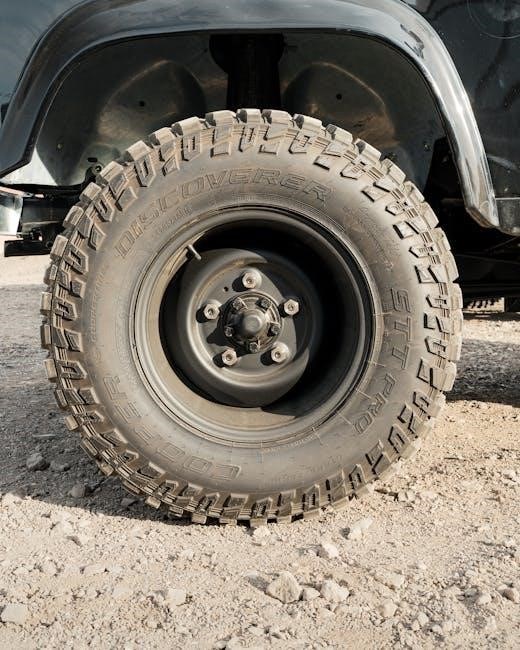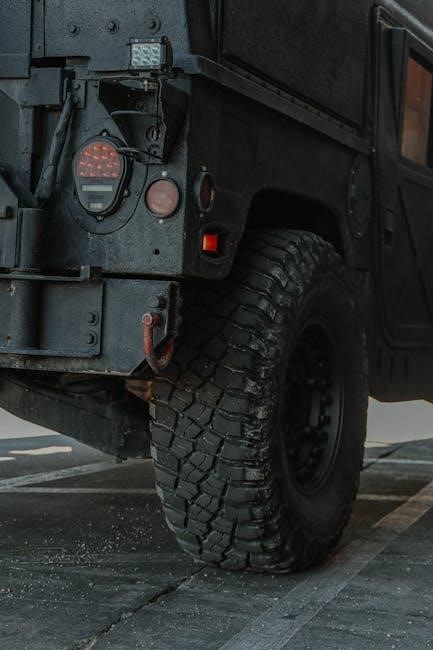off road tire size guide
Summary
Find the perfect off-road tires with our comprehensive size guide. Get the right fit for your adventure!

Understanding Off-Road Tire Size: A Comprehensive Guide
Mastering off-road tire sizing is crucial for optimal performance, safety, and traction. This guide deciphers tire size codes, load ratings, tread patterns, and diameter impact, ensuring you make informed decisions for your off-road adventures. Learn how to choose the right fit for your vehicle and terrain demands.
Understanding off-road tire sizing is essential for ensuring your vehicle performs optimally in challenging terrains. Tire size directly impacts traction, ground clearance, and overall vehicle stability. The sizing information, typically found on the sidewall, includes width, diameter, load rating, and sidewall strength. These components are critical for matching your tires to your vehicle’s specifications and the demands of off-road environments. Incorrect tire size can lead to poor performance, reduced safety, and potential damage to your vehicle. This guide will help you decipher the meaning behind tire size codes and how they apply to your off-road needs. By grasping the fundamentals, you’ll be better equipped to select tires that enhance your off-road experience. Whether you’re tackling rocky trails or muddy terrains, the right tire size ensures reliability and control. Knowing how to read and interpret tire size information is the first step toward making informed decisions for your off-road adventures.

Key Components of a Tire Size
A tire size is typically represented by a series of numbers and letters, such as 35×12.5R17. Breaking this down, the first number (35) represents the tire’s diameter in inches, while the second number (12.5) indicates the tire’s width, also in inches. The letter R denotes the tire’s construction type (Radial in this case), and the final number (17) is the rim diameter, measured in inches. Understanding these components is vital for ensuring proper fitment and performance. The diameter affects ground clearance and how the tire interacts with the terrain, while the width influences traction and stability. Additionally, the load rating and speed rating, often indicated by a separate code, are critical for determining the tire’s capacity and safe operating limits. Accurately interpreting these elements ensures your tires are compatible with your vehicle and meet your off-road demands. Matching these specifications is essential for safety and optimal performance in various off-road conditions.
Load Ratings and Sidewall Strength

Load ratings and sidewall strength are critical factors in selecting off-road tires, as they determine the tire’s ability to handle weight and withstand harsh conditions. The load rating, often denoted by a letter (e.g., C, D, or E), indicates the tire’s maximum weight-carrying capacity. Exceeding this rating can lead to tire failure, making it essential to match the tire’s load rating to your vehicle’s specifications and the weight it will carry. Sidewall strength, measured by the ply rating, reflects the tire’s resistance to punctures and deformation. Higher ply ratings (e.g., 8-ply or 10-ply) are preferred for off-road use due to their durability in rugged terrain. Load range is another key term, with higher ranges (e.g., Load Range E) offering greater strength and load capacity. Properly balancing load ratings with sidewall strength ensures optimal performance and safety, whether navigating rocky trails or carrying heavy payloads. Always consult your vehicle’s Gross Vehicle Weight Rating (GVWR) and tire manufacturer guidelines to make informed decisions. Understanding these factors is vital for ensuring your tires can handle the demands of off-road adventures.
Tread Patterns: Choosing the Right Design
Selecting the appropriate tread pattern is essential for maximizing off-road performance, as different designs excel in specific terrains. Tread patterns vary in lug size, spacing, and complexity, influencing traction, durability, and noise levels. All-terrain tires offer a balanced design, suitable for both on-road comfort and light off-road use, with moderate lug sizes that provide sufficient grip without excessive noise. Mud-terrain tires feature aggressive, large lugs with substantial spacing to eject mud and debris, enhancing grip in deep mud and loose dirt. Rock-crawler tires boast specialized designs with extra-large, tightly spaced lugs for exceptional rock grip and durability in jagged, uneven terrain. Tire manufacturers carefully test tread patterns to balance traction, durability, and noise, ensuring optimal performance across various conditions. Maintenance and longevity considerations include potential wear on paved roads with aggressive patterns and the need for tougher designs in harsh off-road environments. Vehicle-specific needs, such as weight and suspension, also influence tread pattern selection, with heavier vehicles requiring more robust designs. Personal preferences play a role, with some prioritizing longevity and comfort over off-road capability. Researching specific tread patterns and their performance in various conditions is crucial for making an informed decision. Ultimately, the right tread pattern balances performance, durability, and comfort based on intended use and terrain.

Tire Diameter: How It Impacts Performance
Tire diameter plays a critical role in off-road performance, influencing ground clearance, obstacle navigation, and overall traction. A larger diameter provides increased ground clearance, allowing vehicles to traverse deeper ruts, rocks, and uneven terrain with greater ease. This enhanced clearance also improves approach and departure angles, reducing the risk of scraping or damaging the vehicle. However, larger tires can lead to reduced power and torque at lower speeds, as the engine must work harder to propel them. Conversely, smaller tires offer better acceleration and responsiveness, making them more suitable for lighter vehicles or smoother terrains. The trade-off lies in the balance between clearance and power delivery. For extreme off-road conditions, larger tires are often preferred, while smaller diameters are ideal for mixed or lighter-duty applications. Always ensure the chosen diameter aligns with the vehicle’s suspension and drivetrain capabilities to maintain optimal performance and avoid mechanical stress. Proper diameter selection enhances both capability and comfort, tailoring the vehicle to specific off-road demands and driver preferences.

Tire Width: Balancing Fitment and Capability
Tire width significantly impacts an off-road vehicle’s performance, stability, and overall capability. Wider tires provide a larger contact patch, enhancing traction and stability on various terrains. However, excessively wide tires may not be ideal for all conditions, as they can hinder maneuverability in tight spaces. Narrower tires, on the other hand, excel in mud or sand by allowing the tire to penetrate the surface for better grip. The choice of tire width must also consider the vehicle’s fitment, as improper sizing can lead to rubbing against fenders or other components. Additionally, tire width affects load ratings, with wider tires often supporting heavier loads. Aesthetic preferences may influence decisions, but functionality should remain the priority. Maintenance is another factor, as wider tires can be more costly and wear differently than narrower ones. Ultimately, selecting the right tire width requires balancing these factors based on the vehicle’s intended use and the terrain it will encounter. Consulting manufacturer guidelines and professional advice ensures optimal performance and compatibility.
How to Choose the Right Off-Road Tire Size
Choosing the right off-road tire size involves a careful balance of fitment, performance, and functionality. Start by assessing your primary off-road conditions—whether rocky, muddy, or sandy—as this dictates the tread pattern and tire width. Wider tires offer better stability but may not fit all vehicles, so always check manufacturer recommendations to avoid rubbing or clearance issues.
Load ratings are crucial, especially for heavy loads or towing. Ensure the tires’ load capacity matches your vehicle’s weight and intended use. Sidewall strength is another factor; thicker sidewalls enhance durability on rough terrains but may compromise ride comfort.
Tread patterns vary: all-terrain tires provide a balance for mixed use, while mud-terrain tires excel in deep mud but can be noisier on pavement; Consider tire diameter for ground clearance, though larger tires may affect speedometer accuracy and require gear adjustments.
Consult professionals or enthusiast reviews for insights tailored to your vehicle and needs. Finally, weigh maintenance and cost—durable tires may justify higher upfront costs. Proper inflation and regular inspections are vital for longevity and performance.
Top Brands for Off-Road Tires
When it comes to off-road tires, several brands stand out for their quality, durability, and performance. BFGoodrich, renowned for its All-Terrain T/A tires, is a favorite among enthusiasts, offering exceptional traction on various terrains. Goodyear, with its Wrangler series, provides robust options for both on-road comfort and off-road capability. Michelin, known for its rugged designs, offers tires like the LTX Force that excel in challenging conditions. Nitto, specializing in high-performance off-road tires, is praised for its Mud Grappler and Trail Grappler lines, designed for specific terrains. Maxxis, another prominent brand, delivers affordable yet reliable tires that withstand harsh environments. Cooper Tires and Falken also make notable mentions, with their Discoverer and Wildpeak series, respectively, catering to diverse off-road needs. These brands are trusted by adventurers and professionals alike, ensuring superior grip, stability, and endurance for 4x4s, trucks, and SUVs. Choosing the right brand depends on your vehicle type, driving habits, and terrain preferences.
Installation Tips for Off-Road Tires

Installing off-road tires requires careful attention to ensure safety and optimal performance. Start by selecting tires that match your vehicle’s specifications and the intended terrain. Always deflate tires slightly before mounting to prevent damage. Use a modern tire changer to avoid wheel damage and ensure the bead is seated correctly. Inflate tires to the recommended pressure for your vehicle and terrain, adjusting as needed for load or conditions. After installation, inspect the rims for any debris or damage and tighten lug nuts in a star pattern to ensure even pressure. Consider consulting a professional if you’re inexperienced with off-road tire installations. Finally, test drive your vehicle to ensure proper balance and traction, and make adjustments as necessary. Proper installation ensures safety, enhances performance, and extends the life of your tires. Always refer to your vehicle’s manual for specific guidelines and recommendations for your off-road setup.
Maintenance and Care for Off-Road Tires
Proper maintenance and care are essential to extend the life of your off-road tires and ensure optimal performance. Start by regularly checking tire pressure, as under-inflated tires can overheat and wear unevenly. Use a tire pressure gauge to ensure pressures match the manufacturer’s recommendations for your load and terrain. Inspect tires for punctures, cuts, or sidewall damage after every off-road excursion. Clean tires thoroughly with mild soap and water to remove dirt and debris that can degrade the rubber. Rotate tires periodically to promote even tread wear, especially if you frequently drive in harsh conditions. Store spare tires in a cool, dry place, away from direct sunlight, to prevent premature aging. Avoid using harsh chemicals or abrasive cleaners, as they can damage the rubber compounds. Finally, have your tires professionally inspected every 6 months or after extreme use. By following these maintenance tips, you can maximize traction, durability, and safety, ensuring your off-road tires perform at their best for years to come.